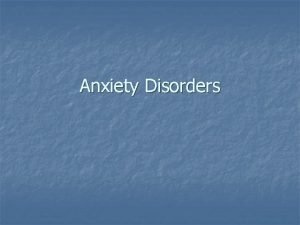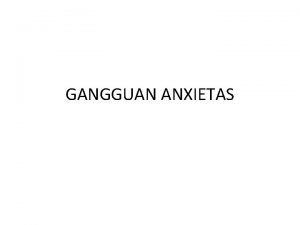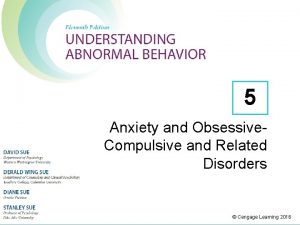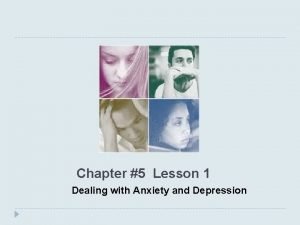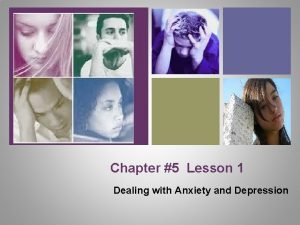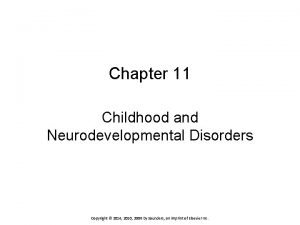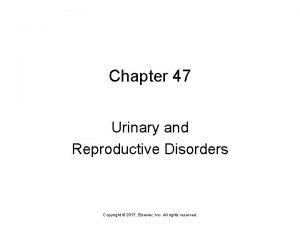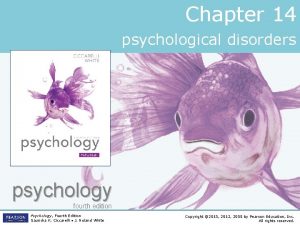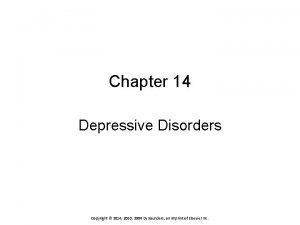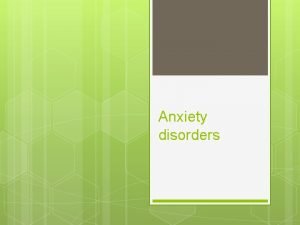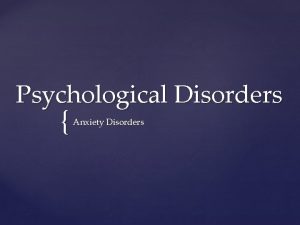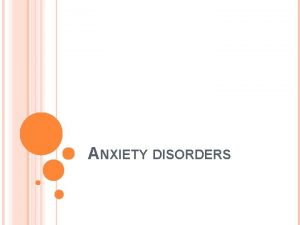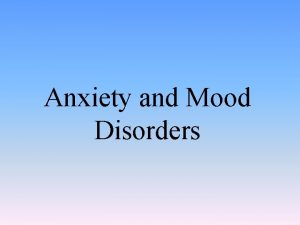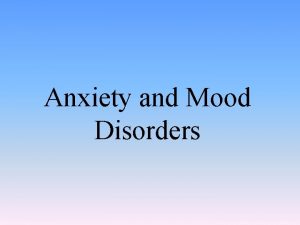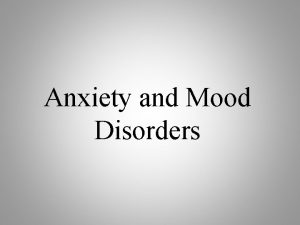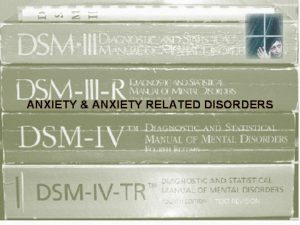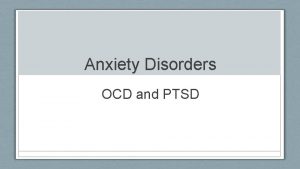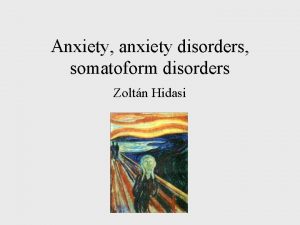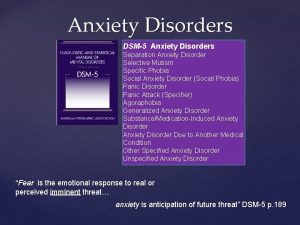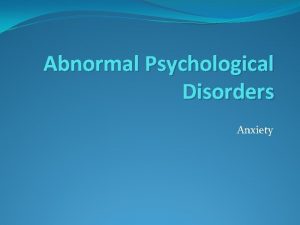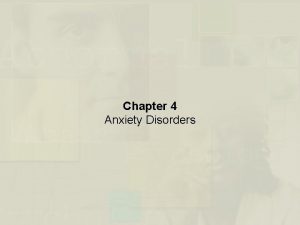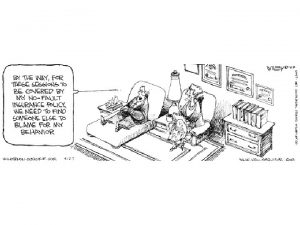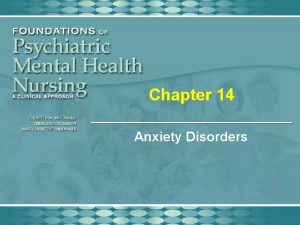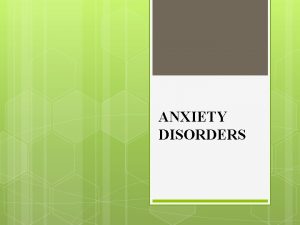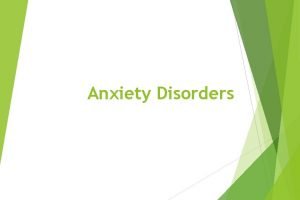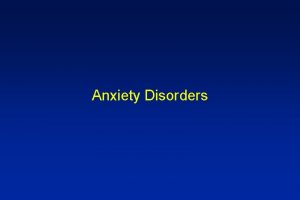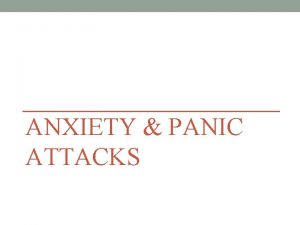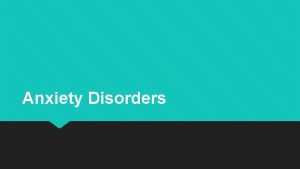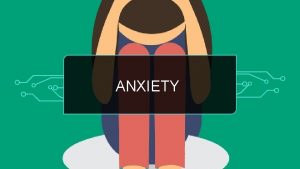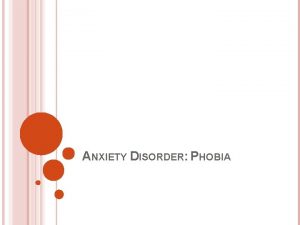Chapter 4 Anxiety Disorders Nature of Anxiety and
































- Slides: 32

Chapter 4 Anxiety Disorders

Nature of Anxiety and Fear Anxiety § Future-oriented mood state § Characterized by marked negative affect § Somatic symptoms of tension § Apprehension about future danger or misfortune Fear § Present-oriented mood state, marked negative affect § Immediate fight or flight response to danger or threat § Strong avoidance/escapist tendencies § Abrupt activation of the sympathetic nervous system Anxiety and Fear are Normal Emotional States State vs. Trait

From Normal to Disordered Anxiety and Fear Characteristics of Anxiety Disorders § Psychological disorders – Pervasive and persistent symptoms of anxiety and fear § Involve excessive avoidance and escapist tendencies § Causes clinically significant distress and impairment

Biological Contributions to Anxiety and Panic Diathesis-Stress § Inherit vulnerabilities for anxiety and panic, not disorders § Stress and life circumstances activate vulnerability Biological Causes and Inherent Vulnerabilities § Anxiety and brain circuits – GABA, noradrenergic and serotonergic systems § Corticotropin releasing factor (CRF) and the HPAC axis § Limbic (amygdala) and the septal-hippocampal systems § Behavioral inhibition (BIS) and fight/flight (FF) systems

Psychological Contributions to Anxiety and Fear Began with Freud § Anxiety is a psychic reaction to danger § Anxiety involves reactivation of an infantile fear situation Behavioristic Views § Anxiety and fear result from classical and operant conditioning and modeling Psychological Views § Early experiences with uncontrollability / unpredictability Social Contributions § Stressful life events trigger vulnerabilities § Many stressors are familial and interpersonal

Toward an Integrated Model Integrative View § Biological vulnerability interacts with psychological, experiential, and social variables to produce an anxiety disorder § Consistent with diathesis-stress model Common Processes: The Problem of Comorbidity § Comorbidity is common across the anxiety disorders § About half of patients have > 2 or more secondary diagnoses § Major depression is the most common secondary diagnosis § Comorbidity suggests common factors across anxiety disorders § Anxiety and depression are closely related

The Anxiety Disorders: An Overview Generalized Anxiety Disorder Panic Disorder with and without Agoraphobia Specific Phobias Social Phobia Posttraumatic Stress Disorder Obsessive-Compulsive Disorder

Generalized Anxiety Disorder: The “Basic” Anxiety Disorder Overview and Defining Features § Excessive uncontrollable anxious apprehension and worry § Coupled with strong, persistent anxiety § Somatic symptoms differ from panic (e. g. , muscle tension, fatigue, irritability) § Persists for 6 months or more Facts and Statistics § GAD affects 4% of the general population § Females outnumber males approximately 2: 1 § Onset is often insidious, beginning in early adulthood § Tendency to be anxious runs in families

Generalized Anxiety Disorder: Associated Features and Treatment Associated Features § Persons with GAD -- Called “autonomic restrictors” § Fail to process emotional component -- thoughts / images Treatment of GAD § Benzodiazapines – Often prescribed § Psychological interventions – Cognitive-Behavioral Therapy

Generalized Anxiety Disorder: Associated Features and Treatment Figure 5. 5 An integrative model of generalized anxiety disorder

The Phenomenology of Panic Attacks What Is a Panic Attack? § Abrupt experience of intense fear or discomfort § Accompanied by several physical symptoms DSM-IV Subtypes of Panic Attacks § Situationally bound (cued) panic § Unexpected (uncued) panic § Situationally predisposed panic Panic Is Analogous to Fear as an Alarm Response

Panic Disorder with and without Agoraphobia Overview and Defining Features § Experience of unexpected panic attack – A false alarm § Anxiety, worry, or fear about having another attack § Agoraphobia – Fear or avoidance of situations/events § Symptoms and concern persists for 1 month or more Facts and Statistics § Panic disorder affects about 3. 5% of the population § Two thirds with panic disorder are female § Onset is often acute, beginning between ages 25 -29


Panic Disorder: Associated Features and Treatment Associated Features § Nocturnal panic attacks – 60% panic during non-REM sleep § Interoceptive/exteroceptive avoidance, catastrophic misinterpretation of symptoms Medication Treatment of Panic Disorder § Target serotonergic, noradrenergic, and benzodiazepine GABA systems § SSRIs (e. g. , Prozac and Paxil) – Preferred drugs § Relapse rates are high following medication discontinuation Psychological and Combined Treatments of Panic Disorder § Cognitive-behavior therapies are highly effective § No long-term advantage for combined treatments § Best long-term outcome – Cognitive-behavior therapy alone

Specific Phobias: An Overview and Defining Features § Extreme and irrational fear of a specific object or situation § Markedly interferes with one's ability to function § Recognize fears are unreasonable § Still go to great lengths to avoid phobic objects Facts and Statistics § Affects about 11% of the general population § Females are again over-represented § Phobias run a chronic course § Onset beginning between 15 and 20 years of age


Specific Phobias: Associated Features and Treatment Associated Features and Subtypes of Specific Phobia § Blood-injury-injection phobia – Vasovagal response § Situational phobia – Public transportation or enclosed places (e. g. , planes) § Natural environment phobia – Events occurring in nature (e. g. , heights, storms) § Animal phobia – Animals and insects § Other phobias – Do not fit into the other categories (e. g. , fear of choking, vomiting) § Separation anxiety disorder – Children’s worry that something will happen to parents

Specific Phobias: Associated Features and Treatment (cont. ) Causes of Phobias § Biological and evolutionary vulnerability, direct conditioning, observational learning, information transmission Psychological Treatments of Specific Phobias § Cognitive-behavior therapies are highly effective § Structured and consistent graduated exposure

Social Phobia: An Overview and Defining Features § Extreme and irrational fear/shyness § Focused on social and/or performance situations § Markedly interferes with one's ability to function § May avoid social situations or endure them with distress § Generalized subtype – Anxiety across many social situations Facts and Statistics § Affects about 13% of the general population at some point § Females are slightly more represented than males § Onset is usually during adolescence § Peak age of onset at about 15 years


Social Phobia: Associated Features and Treatment Causes of Phobias § Biological and evolutionary vulnerability § Direct conditioning, observational learning, information transmission Medication Treatment of Social Phobia § Beta blockers -- Are ineffective § Tricyclic antidepressants -- Reduce social anxiety § Monoamine oxidase inhibitors – Reduce reduce anxiety § SSRI Paxil – FDA approved for social anxiety disorder § Relapse rates – High following medication discontinuation

Social Phobia: Associated Features and Treatment (cont. ) Psychological Treatment of Social Phobia § Cognitive-behavioral treatment – Exposure, rehearsal, role-play in a group setting § Cognitive-behavior therapies are highly effective

Posttraumatic Stress Disorder (PTSD): An Overview and Defining Features § Requires exposure to a traumatic event § Person experiences extreme fear, helplessness, or horror § Continue to re-experience the event (e. g. , memories, nightmares, flashbacks) § Avoidance of reminders of trauma § Emotional numbing § Interpersonal problems are common § Markedly interferes with one's ability to function § PTSD diagnosis – Only 1 month or more post-trauma

Posttraumatic Stress Disorder (PTSD): An Overview (cont. ) Facts and Statistics § Affects about 7. 8% of the general population Most Common Traumas § Sexual assault § Accidents § Combat

Posttraumatic Stress Disorder (PTSD): Causes and Associated Features Subtypes and Associated Features of PTSD § Acute PTSD – May be diagnosed 1 -3 months post trauma § Chronic PTSD – Diagnosed after 3 months post trauma § Delayed onset PTSD – Symptoms begin after 6 months or more post trauma § Acute stress disorder – Diagnosis of PTSD immediately post-trauma Causes of PTSD § Intensity of the trauma and one’s reaction to it § Uncontrollability and unpredictability § Extent of social support, or lack thereof post-trauma § Direct conditioning and observational learning


Posttraumatic Stress Disorder (PTSD): Treatment Psychological Treatment of PTSD § Cognitive-behavioral treatment involves graduated or massed imaginal exposure § Increase positive coping skills and social support § Cognitive-behavior therapies are highly effective

Obsessive-Compulsive Disorder (OCD): An Overview and Defining Features Obsessions § Intrusive and nonsensical thoughts, images, or urges that one tries to resist or eliminate Compulsions § Thoughts or actions to suppress thoughts § Provide relief Most persons with OCD display multiple obsessions Many with cleaning, washing, and/or checking rituals

Obsessive-Compulsive Disorder (OCD): Causes and Associated Features Facts and Statistics § Affects about 2. 6% of the population at some point § Most persons with OCD are female § OCD tends to be chronic § Onset is typically in early adolescence or adulthood Causes of OCD § Parallel the other anxiety disorders § Early life experiences and learning that some thoughts are dangerous/unacceptable § Thought-action fusion – The thought is like the action


Obsessive-Compulsive Disorder (OCD): Treatment Medication Treatment of OCD § Clomipramine and other SSRIs – Benefit about 60% § Psychosurgery (cingulotomy) – Used in extreme cases § Relapse is common with medication discontinuation Psychological Treatment of OCD § Cognitive-behavioral therapy – Most effective for OCD § CBT involves exposure and response prevention § Combined treatments – Not better than CBT alone

Summary of Anxiety-Related Disorders Anxiety Disorders Are the Largest Domain of Psychopathology From a Normal to a Disordered Experience of Anxiety and Fear § Requires consideration of biological, psychological, experiential, and social factors § Fear and anxiety in the absence of real threat or danger § Develop avoidance, restricted life functioning § Cause significant distress and impairment in functioning Psychological Treatments § Are Generally Superior in the Long-Term § Treatments include similar components § Suggests that anxiety disorders share common processes
 Chapter 15 anxiety and obsessive-compulsive disorders
Chapter 15 anxiety and obsessive-compulsive disorders Anxiety disorders def
Anxiety disorders def Icd 10 panic disorder
Icd 10 panic disorder Multipath model of anxiety disorders
Multipath model of anxiety disorders Chapter 8 managing stress and anxiety
Chapter 8 managing stress and anxiety Chapter 5 lesson 1 dealing with anxiety and depression
Chapter 5 lesson 1 dealing with anxiety and depression Chapter 5 lesson 1 dealing with anxiety and depression
Chapter 5 lesson 1 dealing with anxiety and depression Nature and nature's law lay hid in night meaning
Nature and nature's law lay hid in night meaning Chapter 8 skin disorders and diseases
Chapter 8 skin disorders and diseases Chapter 6 musculoskeletal system
Chapter 6 musculoskeletal system Chapter 46 digestive and endocrine disorders
Chapter 46 digestive and endocrine disorders Chapter 29 somatic symptom and dissociative disorders
Chapter 29 somatic symptom and dissociative disorders Chapter 29 endocrine and metabolic disorders
Chapter 29 endocrine and metabolic disorders Chapter 21 mental health diseases and disorders
Chapter 21 mental health diseases and disorders Chapter 18 eating and feeding disorders
Chapter 18 eating and feeding disorders Chapter 17 reproductive system diseases and disorders
Chapter 17 reproductive system diseases and disorders Chapter 15 nervous system diseases and disorders
Chapter 15 nervous system diseases and disorders Chapter 11 childhood and neurodevelopmental disorders
Chapter 11 childhood and neurodevelopmental disorders Chapter 8 skin disorders and diseases
Chapter 8 skin disorders and diseases In what situation should a nail service not be performed
In what situation should a nail service not be performed Nail diseases and disorders milady
Nail diseases and disorders milady Chapter 8 cardiovascular system
Chapter 8 cardiovascular system Milady chapter 8 skin disorders and diseases
Milady chapter 8 skin disorders and diseases Chapter 47 urinary and reproductive disorders
Chapter 47 urinary and reproductive disorders Chapter 11 managing weight and eating behaviors
Chapter 11 managing weight and eating behaviors 10 diseases of lymphatic system
10 diseases of lymphatic system Chapter 18 managing anxiety
Chapter 18 managing anxiety Nature nature controversy
Nature nature controversy Chapter 18 psychological disorders review worksheet
Chapter 18 psychological disorders review worksheet Chorionic villus
Chorionic villus Chapter 18 psychological disorders
Chapter 18 psychological disorders Chapter 14 psychological disorders
Chapter 14 psychological disorders Chapter 14 depressive disorders
Chapter 14 depressive disorders

